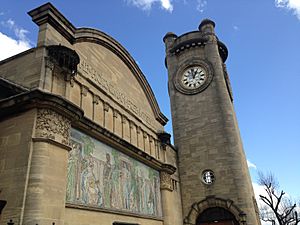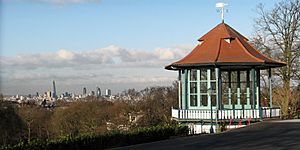Horniman Museum facts for kids
 |
|
| Lua error in Module:Location_map at line 420: attempt to index field 'wikibase' (a nil value). | |
| Established | 1901 |
|---|---|
| Location | 100 London Road, Forest Hill London, SE23 3PQ United Kingdom |
| Visitors | 952,954 (2019) |
| Public transit access |
|
The Horniman Museum and Gardens is a super interesting museum in Forest Hill, London, England. It first opened its doors in 1901. The museum was designed by Charles Harrison Townsend in a special style called the Modern Style.
This museum is famous for its amazing collections. You can explore anthropology (the study of human societies and cultures), natural history (all about animals and plants), and musical instruments. One of its most well-known features is a huge collection of stuffed animals. The main building is also a very important historical building, known as Grade II* listed.
In 2022, the Horniman Museum won a big award called Museum of the Year from the Art Fund. It's a really special place to visit and learn new things!
Contents
A Look Back: The Museum's History
The Horniman Museum was started in 1901 by a man named Frederick John Horniman. Frederick inherited his family's tea business, called Horniman's Tea. By 1891, this business had grown to be the biggest tea trading company in the world!
Frederick used the money from his successful business to follow his passion: collecting things. He traveled all over the world and gathered about 30,000 items. His collections included objects from nature, cultural items from different societies, and many musical instruments.
In 1911, Frederick's son, Emslie Horniman, added another building to the museum. This new part had a lecture hall and a library. Later, in 2002, a brand new extension was opened, giving the museum even more space.
In 2007, the museum hosted a cool exhibition called Walking with Beasts. It featured life-sized models of extinct animals. These included creatures like the Smilodon (saber-toothed cat) and the Woolly Mammoth, just like those seen in the famous BBC TV series.
As mentioned, the museum won the prestigious Art Fund's Museum of the Year award in 2022. In November 2022, the museum also made headlines for returning 72 items, including some famous Benin Bronzes, to Nigeria. These items had been taken from the Kingdom of Benin a long time ago.
Amazing Collections to Explore
The Horniman Museum is a specialist in three main areas: human cultures (anthropology), the natural world (natural history), and musical instruments. It holds an incredible collection of 350,000 objects! Many of its cultural and music collections have a special "Designated status." This means they are recognized as being very important to the history and culture of England.
One of the most famous things you'll see is the huge collection of stuffed animals. The museum also has an aquarium with a unique design, making it a fun place to see underwater creatures.
What's on Each Floor?
Here's a quick guide to what you can find on each floor of the museum:
| 1st Floor | Ground Floor | Lower Ground Floor | Basement Floor |
|---|---|---|---|
| Under 5s Book Zone Natural History Balcony Horniman Highlight Objects 3 Apostle Clock, Germany |
Main Entrance CUE Building Conservatory Café Shop Education Centre Hands On Base Natural History Gallery Balcony Gallery Environment Room Horniman Highlight Objects 1 Sand Painting, America 2 Walrus, Canada |
World Gallery Temporary Exhibition Gallery Music Gallery Gallery Square Security Reception from London Road Horniman Highlight Objects 4 French Horn, England 5 Carlton Drum Kit, England 7 Kali with Shiva Figure, India 8 Benin Plaques, Nigeria |
Aquarium |
Getting There: Transport Connections
It's easy to get to the Horniman Museum using public transport:
| Service | Station/Stop | Lines/Routes served | Distance from Horniman Museum |
|---|---|---|---|
| London Buses |
Horniman Museum |
176, 185, 197, 356, P4 | |
| Horniman Park |
363 | 260 m (850 ft) walk | |
| London Overground |
Forest Hill |
Windrush line | 650 m (2,130 ft) walk |
| National Rail |
Southern |
Exploring the Gardens
The museum is surrounded by 16 acres of beautiful gardens. These gardens are a fantastic place to explore and relax. They are also recognized as a Grade II listed site, meaning they are historically important.
Here are some cool things you can find in the gardens:
- A lovely conservatory from 1894. It was moved here from the Horniman family's old house.
- A historic bandstand from 1912, perfect for outdoor performances.
- An enclosure where you can see small animals.
- A special Butterfly House, full of colorful butterflies.
- A nature trail to discover local plants and wildlife.
- An ornamental garden with beautiful flowers and designs.
- Gardens dedicated to plants used for medicines, foods, and dyes.
- A fun sound garden with large musical instruments you can play!
- A new building called the Pavilion, used for working with materials from the gardens.
The Big Mosaic Mural
On the London Road side of the main museum building, there's a huge and impressive mosaic mural. It's called Humanity in the House of Circumstance. A mosaic is a picture made from many small pieces of colored glass or stone. This one was designed by Robert Anning Bell.
It took a group of young women 210 days to put together this amazing artwork. It's about 10 feet tall and 32 feet wide, made from over 117,000 tiny pieces! The mosaic shows different figures that represent ideas about life and our goals.
For example, the figures on the left stand for Art, Poetry, and Music. They are near a doorway that means birth. An armed figure represents Endurance, showing strength. Two kneeling figures stand for Love and Hope. The main figure in the middle represents all of Humanity. Other figures show Charity, Wisdom, Meditation, and Resignation, near a doorway that means death.
The Tall Totem Pole
Right outside the museum's main entrance, you'll see a tall, 20-foot totem pole. It was carved from red cedar wood in 1985 by Nathan Jackson, a Tlingit native Alaskan artist.
The carvings on the pole tell stories from Alaskan legends. They show figures from a tale about a girl who married a bear. At the very top, you can see an eagle, which is Nathan Jackson's family symbol. This totem pole is one of only a few in the United Kingdom.
The CUE Building
The Horniman Museum also has a special building called the CUE (Centre for Understanding the Environment) building. It opened in 1996 and was designed to be very eco-friendly.
This building has a grass roof and was made using sustainable materials. It also uses clever ways to keep the air fresh and cool without needing lots of energy.
Images for kids















